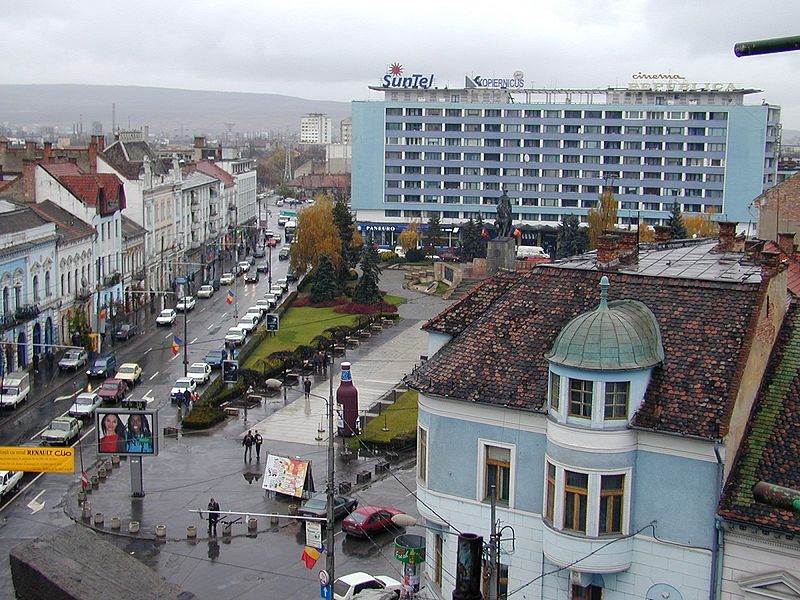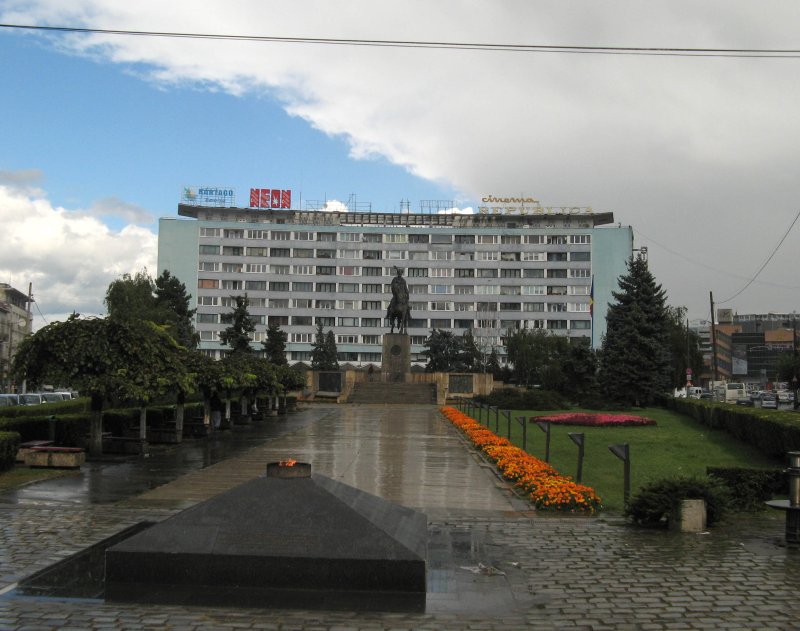[RO]
 Piata “Mihai Viteazul”, a treia ca importanta a
orasului, este dominata de statuia ecvestra a lui Mihai Viteazul
(1558-1601) si marginita de cateva palate cu o arhitectura
deosebita.
Piata “Mihai Viteazul”, a treia ca importanta a
orasului, este dominata de statuia ecvestra a lui Mihai Viteazul
(1558-1601) si marginita de cateva palate cu o arhitectura
deosebita.
Desi nu a
constituit punctul central al unirii celor trei Principate Romane
de la 1600, realizata sub domnia sa, Clujul a pastrat numeroase
legaturi comerciale si de natura politica cu Mihai Viteazul iar
legenda spune ca fiul sau, Patrascu, a invatat la Colegiul Iezuit
care functiona in Cluj. Clujenii si oficialitatile maghiare ale
orasului au uneltit mereu impotriva sa, mai mult, dupa ce
domnitorul a fost infrant in lupta de la Miraslau, orasul s-a
razbunat crunt pe oamenii acestuia. Insusi Baba Novac, unul dintre
cei mai viteji capitani ai lui Mihai, a fost ars pe rug, in
februarie 1601, cu putin timp inaintea mortii marelui voevod. Pe
locul in care a fost expus trupul lui Baba Novac, la una dintre
caile de intrare in oras ale acelor vremi, spre a servi de pilda,
se inalta, din 1975, un monument.
Denumita
initial “Szechenyi Istvan”, numele pietei a fost
schimbat in Piata “Mihai Viteazul”, in anul 1919, drept
omagiu adus primului unificator al Romaniei. Locul a primit o
destinatie comerciala si a inflorit abia in a doua jumatate a sec.
al XIX-lea, dupa ce s-a construit aici o cale ferata pentru
transport de oameni si marfuri. Piata de marfuri, care functionase
pana atunci in centru, a fost mutata, insa linia ferata a fost
desfiintata din cauza numeroaselor accidente, ultimul transport
fiind cel al pieselor statuii lui Matei Corvin, in 1902.
Din Piata
“Mihai Viteazul” se poate ajunge la gara, traversand
podul peste Somes, la capatul modernului bulevard Horea. De-o parte
si de alta a podului se ridica Palatul Szekely, construit in stil
neogotic in 1893 si Urania, in stil secession, in 1910. Arhitectura
pietei a fost remodelata in anii ’50, cand au fost daramate
casele care nu mai corespundeau noii imagini pe care autoritatile
au dorit sa o imprime locului respectiv. Atunci au fost construite,
printre altele, cladirea Cinematografului "Republica” si Hala
Agroalimentara.
Sursa :
Cluj-Napoca online
Wiki : http://ro.wikipedia.org/wiki/Pia%C8%9Ba_Mihai_Viteazul_din_Cluj-Napoca
[EN]
 "Piata Mihai Viteazul" is the third in order of importance in
Cluj. A small park in the middle is dominated by the equestrian
statue of "Mihai Viteazul" (1558-1601) and surrounded by several
old buildings with dinstinct architecture.
"Piata Mihai Viteazul" is the third in order of importance in
Cluj. A small park in the middle is dominated by the equestrian
statue of "Mihai Viteazul" (1558-1601) and surrounded by several
old buildings with dinstinct architecture.
Though not the
central part of the conquest/unification of 1600 of the romanian
principalities under Mihai Viteazul, the city of Cluj played it's
role having many commercial and political connections with Mihai
Viteazul and legend says his son, Patrascu, attended school at the
Jezuit College here. Hungarian officials from Cluj were against
Mihai Viteazul, intrigue and politics go a long way. After Mihai's
defeat at Miraslau, Baba Novac, one of his famed captains, was
burned in february 1601, little before Mihai's own murder. Where
Baba Novac's body was on display, at the time one of the city
entrances, today there is a statue of Mihai, built in 1975.
Initially
called "Szechenyi Istvan" square, it was changed to "Mihai
Viteazul" in 1919 as homage to the first who united Romania. The
place flourished as a commercial area around mid 19th century,
after a railway was built for both peopleand freight. The
marketplace was transfered here, but the railway was dismantled
after may accidents. The last transport on this rail was the Matei
Corvin statue elements in 1902.
From here one
can go the the train station by crossing the bridge over the Somes
river and following the Horea blvd. On one side of the bridge is
the Szekely palace built in neogotic style in 1893 and Urania,
built in 1910 in secession style.
The
architecture was remodeled in the 50s when older houses were
demolished and a new image was created by the authorities of the
time. Several blocks of flats were build, including the "Republica"
cinema building and the food market building behind the square.